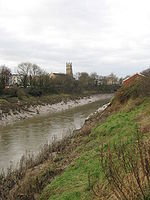Bower Ashton

Bower Ashton is a village in south west Bristol on the western boundary with North Somerset, lying within the Southville ward, approximately two miles from the city centre. Ashton Court estate, a 850-acre (3.4 km2) recreational area owned by Bristol City Council lies just to the north, the Long Ashton by-pass (Brunel Way, the A370) to the south and the River Avon to the east. The area is now mainly residential but also includes the Faculty of Arts, Creative Industries and Education (formerly the School of Creative Arts) of the University of the West of England, Ashton Park School, which is a specialist Sports College, as well as about 180 allotments in 5 different areas. Clifton Bridge and Ashton Gate railway stations are both now closed, but there is some pressure to reopen the latter as part of a rapid transit link from Portishead.
Excerpt from the Wikipedia article Bower Ashton (License: CC BY-SA 3.0, Authors, Images).Bower Ashton
Rownham Close, Bristol Ashton Vale
Geographical coordinates (GPS) Address Nearby Places Show on map
Geographical coordinates (GPS)
| Latitude | Longitude |
|---|---|
| N 51.44166 ° | E -2.62988 ° |
Address
Rownham Close 12
BS3 2JN Bristol, Ashton Vale
England, United Kingdom
Open on Google Maps







